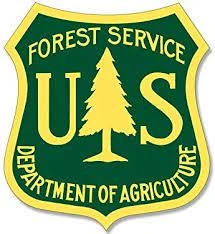
The USFS Project Director is Laurie Porth | US Forest Service Research and Development (usda.gov)
CDSDS Director, Bryan Heidorn coordinates employees for the University of Arizona.
Through our project, “Supporting publication of US Forest Service Experimental Forest and Other Research Data,” we work with the Forest Service Research Data Archive (Archive) to identify a subset of 4 to 6 of the Forest Service’s over 80 experimental areas (primarily experimental forests and ranges) to process historical and modern data.
The objective of this project is to implement protocols and standards for publishing and preserving research data collected using US Forest Service Research & Development funding.
Background
There is an expanded interest in and expectation for researchers to preserve and share the digital scientific data they create. Therefore, US Forest Service-funded scientists submit their data sets and documentation to the Archive for publication and preservation purposes. The Archive’s documentation review process helps to ensure that these published data are not only available but also usable by other scientists and the public for decades to come.
The US Forest Service Experimental Forests and Ranges (EFRs) have been collecting research data for over 100 years. A substantial amount of this data collection resides on paper, and represents studies completed over 30 years ago. "The EFR community believes there is substantial value in these historical data, and that it would therefore be a value-creating activity to publish these data through the Archive."
In addition to the data, each EFR has a collection of paper-based records that the National Archives and Records Administration (NARA) would like to take possession of for long-term stewardship. However, the content of the records is often still in use. Creating a digital version of the record material will enable USFS R&D to meet both sets of needs.
Our Project
Arizona is home to five FS experimental areas. While the overall project can work on any of these, our project has focused on the Fort Valley Experimental Forest (FVEF); https://research.fs.usda.gov/rmrs/forestsandranges/locations/fvef). FVEF is the Forest Service’s oldest EFR; it was established in 1908. The project has been working on documenting this historical record – scanning paper records at archival-level quality, organizing those records, and converting the records into manipulable datasets with sufficient documentation to make the datasets usable to potential users (e.g., scientists, land managers and historians).
For training purposes, we have students or interns also assist USFS staff in publishing non-EFR data sets submitted by scientists for public release. This includes creating and reviewing metadata, processing GIS layers, creating database query interfaces, and other related tasks as determined by USFS staff.
We work with the US Forest Service to determine the best approach to archiving the data sets. Given the age of some of the data sets, new procedures were developed. For example, FS staff were familiar with sheet-fed scanners, but had not previously worked with overhead scanners for large-format and fragile materials. UA staff created a “finding aid” that tracks progress towards the goal of scanning all the paper files and provides fundamental metadata about each scan file. Formal metadata is created to document each data set, along with other descriptive material as appropriate for the particular data set. As appropriate, we also engage in the administrative deposit activities associated with an OAIS-compliant data repository. "Data publications are created following formats developed by the US Forest Service and published via the Archive."
To date, despite COVID restrictions and periodic inability to access FVEF due to severe winter weather conditions, the project has scanned 37,453 pages of research content. Of this, 2,943 pages from 8 research studies have been transcribed into Microsoft Excel to create manipulable datasets. Transcription is intrinsically slower than scanning under the best conditions. UA staff doing transcription have been additionally hindered by many of the pages being original field data collection sheets – with notes that made sense to the people doing the data collection, but we must decipher what they wrote and decode what that means to create a useful entry in Excel.
The UA students involved in the project have all had good things to say about their participation. At least one of the students adapted their experience on the project into a poster presentation at a professional conference.
US Forest Service Research Data Projects
Project Title: U of Arizona data archiving efforts
Funding Agency: USFS
Project Number: 3033030
Amount: $220,050.00
Start Date: July 16, 2019
End Date: March 31, 2024
Description: The project focuses on four Forest Service Experimental Areas in Flagstaff, Arizona, including Fort Valley, Long Valley, Sierra Ancha, and Beaver Creek. These areas have decades of historical research data stored both on paper and in digital files. The goal is to publish this data through the FS Research Data Archive to ensure its availability and usability for scientists and the public, while also creating digital versions of paper records for use by the Forest Service and long-term stewardship by the National Archives and Records Administration.
The project aims to process and publish the research data of Fort Valley Experimental Forest (https://research.fs.usda.gov/rmrs/forestsandranges/locations/fvef), converting both historical and modern data into digital archival formats and publishing them via the FS Research Data Archive. Additionally, it focuses on digitizing Fort Valley's administrative paper records for use by FS staff and NARA, and extends these objectives to another experimental area managed by the FS Flagstaff office.
Project Title: Preserving Research Data from Forest Service Experimental Areas in Arizona
Funding Agency: USFS
Project Number: 3051560
Amount; $140,000.00
Start Date: June 12, 2023
End Date: May 12, 2028
Description:
The project focuses on the Fort Valley Experimental Forest (https://research.fs.usda.gov/rmrs/forestsandranges/locations/fvef ), with a significant portion of its research history still on paper, though 30% has been digitized. It aims to publish data through the FS Research Data Archive. It also includes other Experimental Areas managed by the Flagstaff lab, such as Long Valley, Sierra Ancha, and Beaver Creek. The project focuses on converting paper records with permanent status into digital formats to meet records obligations and assist in program management.
The project focuses on processing and converting Fort Valley's research and administrative records into digital formats, with the intention of publishing them via the Archive. This project explicitly mentions the on-site fieldwork required for converting paper-based materials and considers extending these objectives to another experimental area if resources allow.
Project Title: Proof of Concept for a Forest Service-wide Data Catalog
Funding Agency: USFS
Project Number: 3051570
Amount: $400,000.00
Start Date: September 4, 2023
End Date: November 3, 2026
Description: The project is national in scope, covering data from Districts, Forests, Regions, and the entire National Forest System, particularly wildfire data. The project involves a data librarian working with FS Research Data Services and the Chief Data Officer to integrate data management across multiple programs. It aims to establish a proof of concept that impacts a wide range of Forest Service data creators and users, with guidance from the USDA Axon Data Governance platform to ensure broad and effective data use.
The project aims to create a comprehensive data inventory for the Forest Service to meet Evidence Act requirements, including developing a searchable data catalog with metadata. It targets datasets related to the Wildfire Crisis Strategy and seeks to integrate the selected data catalog platform with the USDA's enterprise data catalog and governance platform, while also marketing published datasets through federal platforms like data.gov and GeoPlatform.
U.S. Forest Service Staff
Current
Laurie Porth (project manager)
Keith Moser (Fort Valley EF principal scientist)
University of Arizona Staff
Past
AJ Beck
Savanna Bunn
Dave Rugg (project manager)
University of Arizona Students
Current
Crystal Brannen
Past
Mitchell Bennett-Tyler
Anna Fitzgerald
Daelyn Rhoden
Mario Villa

